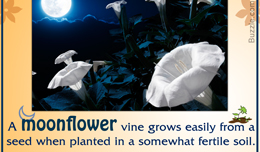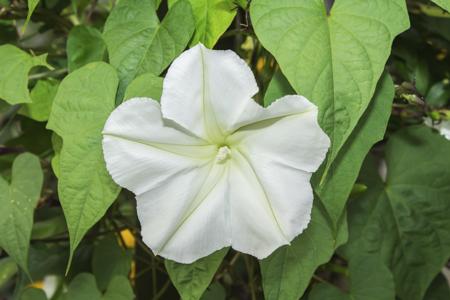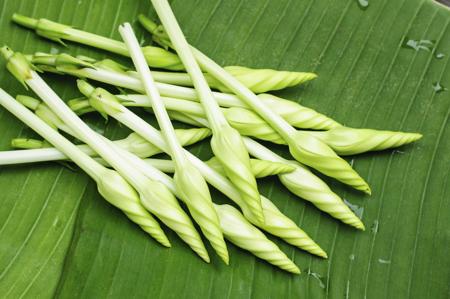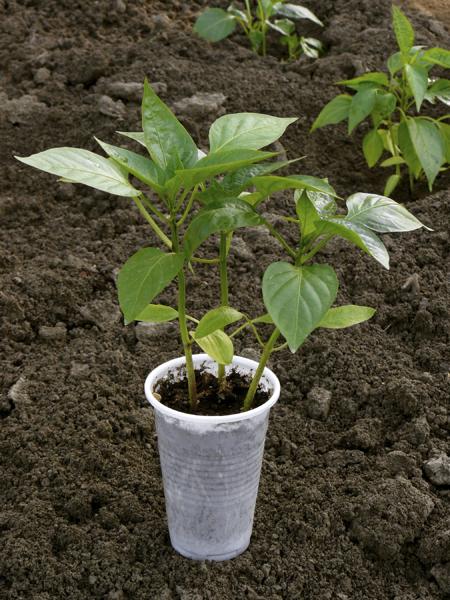Imagine a white blossom that blooms when its dark, perfumes your yard, shines in the moonlight, and shuts in sunlight. If you're patient, you can watch them unfurl right before your eyes. Moonflowers are magical. Growing and nurturing of moonflower vines is discussed here.

Old-time charm
Moonflower signifies "dreaming of love" in the floral language. People, during the 19th century, held parties to watch these lovely nocturnal blooms because of their romantic associations and lovely scent.Ipomoea alba, the Latin name for the moonflower or moon vine, is native to Southern Florida and American tropics. These flowers bloom in the evening time and last through the night, and remain open until kissed by the morning sun. This plant got its name not only from its nocturnal blooming habits, but also because the opened flower looks like a full moon and is white in color. There are many varieties of moonflower, but this article is about Ipomoea alba, the moonflower vine.Plant DescriptionMoonflowers are large trumpet-shaped, white flowers with a lovely fragrance, accompanied with green heart-shaped leaves. The vines grow to a height ranging from 5-30 m tall with twinning stems. The leaves are 5-15 cm long, with a 5-20 cm long stem. Though some moonflowers closely resemble morning glories, as they are close cousins, be careful not to mix them up. They are hardy in USDA zones 8 to 11. They can be grown in an outdoor eating area or near the bedroom window, where their perfume can sweeten the night air.

Moonflower, Ipomoea alba

Closed moonflower budsInstructions for Growing Moonflower VinesSite SelectionMake sure to plant your moonflower vine in an area where they can climb upwards (towards the moon!). This plant can reach up to 20 feet, joyfully twinning and twirling around anything in its reach. Provide support such as a fence or trellis for vines. Plant it along sidewalks and patios, where people are likely to have evening walks.Climate and SoilMoonflower vines are not rigid about the fertility or texture of soil, though they grow easily from a seed when planted in a somewhat fertile soil. When it comes to temperature, a simple formula that would work here is: more sun = more blooms. For planting your moonflower vine outside, the temperature should consistently stay between 60 - 70°F. Light requirements are quite adaptable.Seeding and Planting
 Moonflower plant in a glass-shaped container
Moonflower plant in a glass-shaped containerPrepare the seeds. The seeds should ideally be nicked and soaked in warm water in the beginning. Use a custard cup, a container, or peat pots for placing the seeds. Cover with water. Soak seeds overnight (4 - 8 hours is recommended). Place your container in a warm location.
Propagate the seed indoors 4 - 6 weeks before last spring frost to jump-start the growth of your vines in the season; the soil should be warm to allow germination. Once the frost disappears, seed them outdoors. The ideal temperature for germination should fall in the range of 65°F to 85°F.
Prepare seedlings for transplant. They germinate very easily in around 3 weeks. Before planting, do lessen the seedlings to one vine per pot. Be gentle. Pulling the seedlings from the soil may end up damaging the main seedling. Now, it's time to transplant the seedling. Dig a hole, larger than the peat pot. Infuse the seedling and the peat pot in the planting hole. The pot will disintegrate in the soil, providing the necessary nutrients. Moisten the soil by watering it.WateringMoonflower vines can grow in dry soils as well. Water small plants gently on a regular basis. Large vines should be provided with additional water. Do not clog the soil by overwatering. This, along with excessive sunlight can lead the moonflower buds to fall down, before flowering.FertilizingFertilize with a liquid plant fertilizer, once or twice in the late summer. A high phosphorus fertilizer encourages more blooms on this plant. Too much nitrogen fertilizer may limit blooms. Excessive use of fertilizers will get you a lot of leaves, but not many flowers.Pruning★
Perennial vines: When growing moonflower as a perennial, prune the vines to their ground level in the fall. Cover the roots with a layer of mulch to protect them from winter. You can also cut the vines in early spring or late winters. Always disinfect your pruning tools before and after cutting your flowers. Rinse the pruning shears with clear water or household bleach to prevent the plant from catching diseases.
★
Removing dead/damaged vines: Cut the diseased vines, thus, reducing the chances of the disease spreading to other parts of your vines. Pruning such vines will also allow sunlight to reach the inner parts of your plant and promote aeration.
★
Controlling the shape: Trim the plants for a desirable shape, contributing to its healthy growth. The branches or buds should be cut in the direction you want your plant to grow.Pest controlMoths and hummingbirds love
Ipomoea alba and are highly attracted to their nectar, but then there can be a threat involved if it attracts pests. Normally, in case of moon vines, pests aren't a major problem, but if problems occur, spray insects with water or other natural repellents to get rid of them. If it's severe, treat with organic or chemical insect repellents and fungicides.Point to PonderThe moonflower vines are toxic, so don't let children or pets chew on them, mainly the seed. These are not poisonous if touched, but poisonous if eaten. This vine plant is a self-seeder, pick them off so that they don't form seedpods, and grow into a tree in the next yearMoonflowers are surely worth taking the trouble of growing them. Now that you know how to cultivate and caress them, how about growing moonflowers with morning glories for a sensational blaze all day and night?






 Old-time charmMoonflower signifies "dreaming of love" in the floral language. People, during the 19th century, held parties to watch these lovely nocturnal blooms because of their romantic associations and lovely scent.Ipomoea alba, the Latin name for the moonflower or moon vine, is native to Southern Florida and American tropics. These flowers bloom in the evening time and last through the night, and remain open until kissed by the morning sun. This plant got its name not only from its nocturnal blooming habits, but also because the opened flower looks like a full moon and is white in color. There are many varieties of moonflower, but this article is about Ipomoea alba, the moonflower vine.Plant DescriptionMoonflowers are large trumpet-shaped, white flowers with a lovely fragrance, accompanied with green heart-shaped leaves. The vines grow to a height ranging from 5-30 m tall with twinning stems. The leaves are 5-15 cm long, with a 5-20 cm long stem. Though some moonflowers closely resemble morning glories, as they are close cousins, be careful not to mix them up. They are hardy in USDA zones 8 to 11. They can be grown in an outdoor eating area or near the bedroom window, where their perfume can sweeten the night air.
Old-time charmMoonflower signifies "dreaming of love" in the floral language. People, during the 19th century, held parties to watch these lovely nocturnal blooms because of their romantic associations and lovely scent.Ipomoea alba, the Latin name for the moonflower or moon vine, is native to Southern Florida and American tropics. These flowers bloom in the evening time and last through the night, and remain open until kissed by the morning sun. This plant got its name not only from its nocturnal blooming habits, but also because the opened flower looks like a full moon and is white in color. There are many varieties of moonflower, but this article is about Ipomoea alba, the moonflower vine.Plant DescriptionMoonflowers are large trumpet-shaped, white flowers with a lovely fragrance, accompanied with green heart-shaped leaves. The vines grow to a height ranging from 5-30 m tall with twinning stems. The leaves are 5-15 cm long, with a 5-20 cm long stem. Though some moonflowers closely resemble morning glories, as they are close cousins, be careful not to mix them up. They are hardy in USDA zones 8 to 11. They can be grown in an outdoor eating area or near the bedroom window, where their perfume can sweeten the night air. Moonflower, Ipomoea alba
Moonflower, Ipomoea alba Closed moonflower budsInstructions for Growing Moonflower VinesSite SelectionMake sure to plant your moonflower vine in an area where they can climb upwards (towards the moon!). This plant can reach up to 20 feet, joyfully twinning and twirling around anything in its reach. Provide support such as a fence or trellis for vines. Plant it along sidewalks and patios, where people are likely to have evening walks.Climate and SoilMoonflower vines are not rigid about the fertility or texture of soil, though they grow easily from a seed when planted in a somewhat fertile soil. When it comes to temperature, a simple formula that would work here is: more sun = more blooms. For planting your moonflower vine outside, the temperature should consistently stay between 60 - 70°F. Light requirements are quite adaptable.Seeding and Planting
Closed moonflower budsInstructions for Growing Moonflower VinesSite SelectionMake sure to plant your moonflower vine in an area where they can climb upwards (towards the moon!). This plant can reach up to 20 feet, joyfully twinning and twirling around anything in its reach. Provide support such as a fence or trellis for vines. Plant it along sidewalks and patios, where people are likely to have evening walks.Climate and SoilMoonflower vines are not rigid about the fertility or texture of soil, though they grow easily from a seed when planted in a somewhat fertile soil. When it comes to temperature, a simple formula that would work here is: more sun = more blooms. For planting your moonflower vine outside, the temperature should consistently stay between 60 - 70°F. Light requirements are quite adaptable.Seeding and Planting Moonflower plant in a glass-shaped containerPrepare the seeds. The seeds should ideally be nicked and soaked in warm water in the beginning. Use a custard cup, a container, or peat pots for placing the seeds. Cover with water. Soak seeds overnight (4 - 8 hours is recommended). Place your container in a warm location.
Moonflower plant in a glass-shaped containerPrepare the seeds. The seeds should ideally be nicked and soaked in warm water in the beginning. Use a custard cup, a container, or peat pots for placing the seeds. Cover with water. Soak seeds overnight (4 - 8 hours is recommended). Place your container in a warm location.